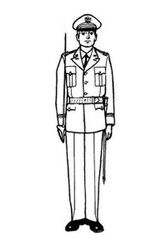Military Swords and Finding the Right Size
26th Feb 2019
Military swords and sabers are revered even though they no longer play a role in combat. Steel symbolized strength and toughness in the early years. Of all the many weapons made of the material since, the sword has been the most celebrated. Swords, including military blades you see today represent that history.
Over the years, swords have been given their own names and styles for different branches of military service. Today, they are an essential part of the officer’s uniform. Granted they may no longer be in active use but military swords represent the discipline, training, and honor that come with wearing the uniform.

What is the right sword size?
If you want a military sword for purely display purposes then its length is not important. However, it becomes essential for those who intend to perform a manual of arms (draw the sword, carry the sword, parade rest, etc.). There’s no one-size-fits-all in this case. A sword that is too long is liable to get in the way of the headgear. It also increases head movement as one is going to the “carry sword” position.
So, how do you find the ideal sword length for performing manual of arms, especially in cases where you don’t have the sword or saber with you? No need to worry, measuring the fit is still possible.
Stand at attention with the arms and fingers extended down your side. Measure the distance from your eye-level to the “V” between the index finger and thumb of your extended hand. From the measurement, subtract two inches for Army NCO, USMC Officer, Air Force, West Point, Army Academy swords and three inches for other models.
Note: If you are within a 1/2” of a sword size, it is recommended you round up to the nearest size. If you are within 1”, round down to the nearest size.
Check out our stunning range of swords and sabers from around the world, made by some of the most skillful craftsmen in the industry.


 Gift Cards
Gift Cards